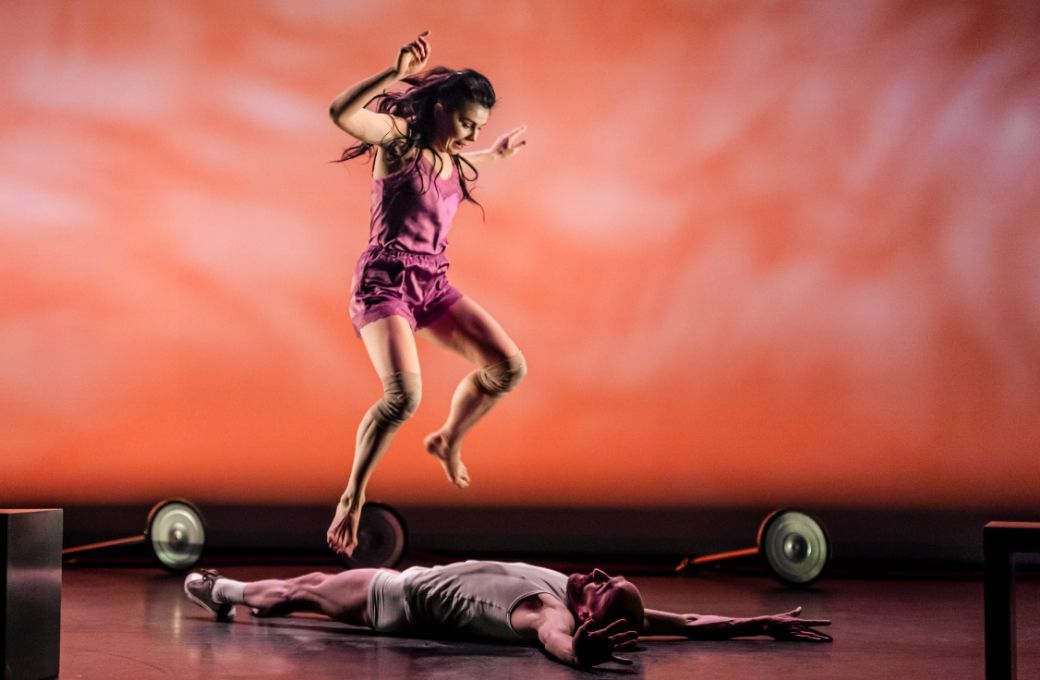‘Osipova/Linbury’ returned last night in an eclectic mix of repertoire that amply shows the ongoing development of an artist capable of almost anything. Natalia Osipova is undoubtedly one of the greatest ballerinas of her generation but what sets her apart is not just her obvious attributes: the big jump, dramatic ability, virtuosic technique and so on. It’s the fearless, unconventional choices and the forays into the new that make her an exciting prospect.
Middle Duet II opened the evening. Alexei Ratmansky’s ballet was first performed in 1998 at the Mariinsky to a piece composed by Yuri Khanon. He was said to be reluctant to allow his music to be used although the ballet was successful. After some years of discontent and legal wrangling, Khanon forbid his score to be used and Ratmansky reinvented the ballet to a commissioned score by Philip Feeney. The result is an interesting if somewhat gloomy duet, overseen by two angels standing in the downstage corners, one white and one black.
Osipova was partnered by the extraordinary Patricio Revé, with whom she danced a memorable and impassioned Romeo and Juliet with The Royal Ballet earlier this year. The chemistry was palpable and there was a certain intensity to every step and breath they took that was extremely compelling. The choreography was typically complex and as always with Ratmansky, exceptionally musical. Movements were sharp and jerky; lifts were often difficult with Osipova being lowered in short, sharp stages. The relationship appeared volatile.
Revé took off in an explosive solo, smooth pirouettes and velvety jumps that soared effortlessly. Osipova leapt in next in an equally charged response. Gone was the gossamer fragility of earlier days, now a powerhouse of energy, it’s impossible not to admire her commitment. As the ballet came to a close, the angels left their posts to make contact with the pair. Was this a good versus evil outcome? I’m not sure, truth be told.
The exquisite film of Osipova dancing Ashton’s Five Brahms Waltzes in the Manner of Isadora Duncan was shown between pas de deux. She is perfectly suited to this, possessing a freedom and sense of emancipation that leapt out of the screen with a freshness and spontaneity. Kate Shipway’s performance on the piano was impeccable.
The second duet of the evening was Akram Khan’s Mud of Sorrow taken from Sacred Monsters, a 2006 collaboration with Sylvie Guillem. Very atmospheric and once again very dark, this was impactful for the way Osipova seemed to remain connected to Revé no matter how much they moved. She clung to him as if her life depended on it. Striking arm movements, always aligned, but like the opening duet, it was angst filled and charged with melancholy. Brilliantly executed, we were nevertheless in need of something more uplifting.

We certainly got it in the second part of the evening with Jo Strømgren’s The Exhibition. It’s a tremendous piece of dance theatre and one of the most entertaining and surprising works I have seen of late. We all knew Osipova could act but wow – she was so funny. The tiniest change of expression brought loud ripples of laughter. Set in an art gallery it regales a meeting of two very different sorts of people. Christopher Akrill’s ordinary bloke in a woolly hat crosses paths with chic, Russian lady in high heels.
Via a series of vignettes we learnt a little about their lives while they interacted in front of projections of different images: a whale, a railway line, a maze, a statue, a torso. She appeared to speak only Russian and he got frustrated when he thought he couldn’t get through to her. Each episode was brilliantly delivered both in words and movement. The two of them were a great foil for each other, highlights being when they tried to pretend they were part of a live installation in front of a flock of seagulls; when Osipova imitated the pose of a statue and when Akrill lost his contact lens. The piece was packed with wit, laughs, cleverness. The real revelation was their performances though. Such astonishing comic timing is a rare thing indeed. I would happily watch this over and over again. A great tonic as the nights draw in.


